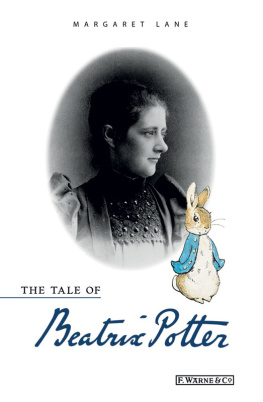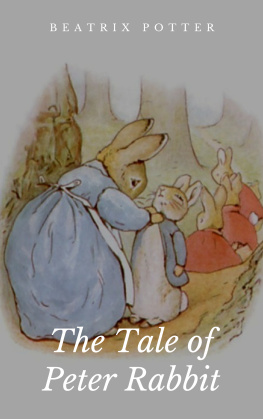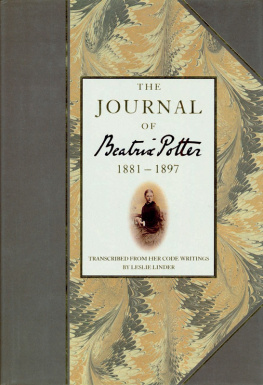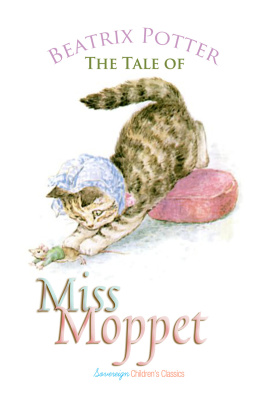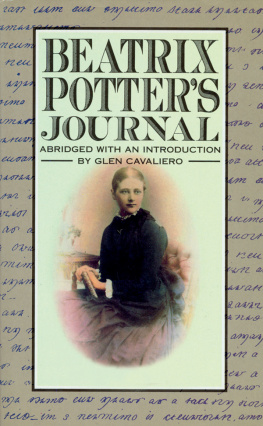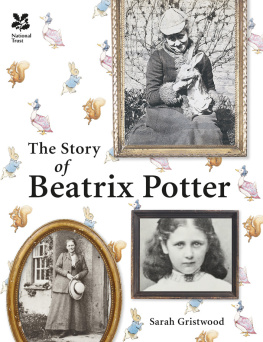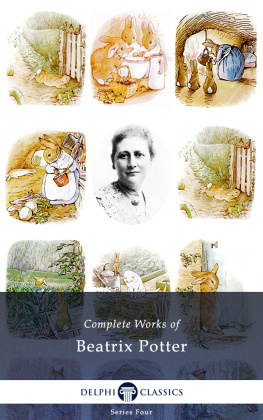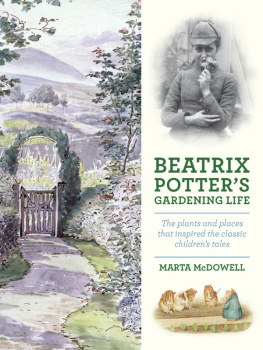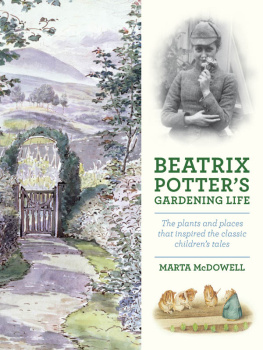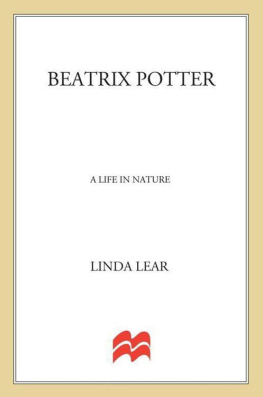The Tale of Beatrix Potter
A BIOGRAPHY BY MARGARET LANE
FREDERICK WARNE
FREDERICK WARNE
Published by the Penguin Group
Penguin Books Ltd, 80 Strand, London WC2R 0RL, England
Penguin Group (USA) Inc., 375 Hudson Street, New York, New York 10014, USA
Penguin Group (Canada), 90 Eglinton Avenue East, Suite 700,
Toronto, Ontario, Canada M4P 2Y3
Penguin Ireland, 25 St Stephens Green, Dublin 2, Ireland
Penguin (Group) Australia, 250 Camberwell Road,
Camberwell, Victoria 3124, Australia
Penguin Books India (P) Ltd, 11 Community Centre,
Panchsheel Park, New Delhi 110 017, India
Penguin Group (NZ), 67 Apollo Drive, Rosedale, North Shore 0632, New Zealand
Penguin Books (South Africa) (Pty) Ltd, P O Box 9, Parklands 2121, South Africa
Penguin Books Ltd, Registered Offices: 80 Strand, London WC2R 0RL, England
Web site at: www.peterrabbit.com
First published by Frederick Warne 1946
Second, revised edition published by Frederick Warne 1985
This edition published by Frederick Warne 2001
Copyright Margaret Lane, 1946, 1985
Illustrations copyright Frederick Warne & Co., 1946, 1985
Frederick Warne & Co. is the owner of all rights, copyrights and trademarks
in the Beatrix Potter character names and illustrations.
All rights reserved. Without limiting the rights under copyright reserved above, no part of this publication may be reproduced, stored in or introduced into a retrieval system, or transmitted in any form or by any means (electronic, mechanical, photocopying, recording or otherwise), without the prior written permission of both the copyright owner and the above publisher of this book.
ISBN: 978-0-72-326552-8
To my daughter
SELINA
Acknowledgements
T HIS life of Beatrix Potter, modest and unsensational though it is, could never have been written without the confidence and help of the late Mr. William Heelis, and the generous assistance of Beatrix Potters family and friends. Without their aid, her biographer must have been entirely at a loss, for her life had been lived so privately, and was so carefully hidden from the public eye, that solitary research would have been all but fruitless. Mr. Heelis gave throughout the most valuable help, and placed many letters and photographs at my disposal, as well as his wifes portfolios and private papers.
Among the members of Beatrix Potters own family who generously lent me letters and supplied information and personal recollections of her early life, I would like specially to remember her cousins, Miss Dora Roscoe and Mrs. Caroline Clark. Mr. and Mrs. W. F. Gaddum and Miss Eileen Bowen-Davis also gave valuable assistance, as did many of Beatrix Potters correspondents and friends, notably Mrs. H. D. Rawnsley, Mrs. Annie Moore, the Rev. Noel Moore, Mrs. James Boultbee, Mrs. Fruing Warne, Miss E. L. Choyce, Miss Margaret Hammond, Miss Janet Adam Smith, Mr. and Mrs. Delmar Banner, Mr. Samuel Cunningham, Miss Bertha Mahony, Miss Helen Dean Fish, Miss Anne Carroll Moore and Miss Mary Gill.
Mr. Leslie Linder, to whose patient and brilliant work on The Journal of Beatrix Potter I owe so much, has my especial gratitude. Without his nine years labour in transcribing that extraordinary document from code, much of the detail of Beatrix Potters early life would have remained unknown.
The firm of Frederick Warne & Company has a special place in Beatrix Potters life, and my debt is great to those members of it, especially Mr. Frederick Warne Stephens and the late Mr. W. A. Herring, who were her personal friends as well as her publishers, and who put their very large collection of letters at my service.
The officials of the National Trust (in particular the then Secretary, Mr. D. M. Matheson, and Mr. B. L. Thompson) were uniformly sympathetic and helpful, and set before me the whole of Beatrix Potters long correspondence with the Trust: I take this opportunity of thanking them. I owe much gratitude, too, to those Herdwick sheep-farmers and shepherds who gave me some little insight into their subject, and into Beatrix Potters work as a breeder and farmer. In this connection it gives me real pleasure to mention with appreciation Mr. W. Wilson, Mr. George Walker, Mr. Thomas Storey, Mr. Thomas Stoddart, Mr. John Cannon and Mr. Joseph Moscrop.
M.L.
Contents
List of Illustrations
Introduction
I N Beatrix Potters middle and old age not many people knew anything about her. Her name, of course, conjured up enchanting childhood memories of Peter Rabbit, Tom Kitten, Jemima Puddle-duck and the rest, but it was generally assumed that she had long been dead.
On the other hand, there was another person, a Mrs. William Heelis, wife of a solicitor in the Lake District, a woman well known locally as a farmer and shrewd purchaser of land, who could be bluntly outspoken at cattle shows and sheep fairs, and who pottered about in her own fields with a stout stick and usually, in wet and windy weather, a meal-sack across her shoulders. It was a fact known to remarkably few people that Beatrix Potter and Mrs. Heelis were one and the same.
This was precisely as she would have wished. She had lived her life through three very different phases, and her sense of personal privacy was extreme. Her childhood cannot be described as happy. Lonely, restricted, in the stuffy and frustrating atmosphere of a prosperous middle-class household in which almost any form of activity was frowned upon, she consoled herself with the company of small animals, chiefly mice and rabbits, which she loved and studied with the absorbing passion of both naturalist and artist. I cannot rest, she wrote in the secret-code journal which she kept from her fourteenth to her thirtieth year, I must draw, however poor the result I will do something sooner or later.
As indeed she did, passing into the second phaseonly thirteen yearsin which her picture-letters to the children of a former governess gradually developed into a series of little published masterpieces. Mrs. Tiggy-winkle and the rest had partly fulfiled her creative urge, andwhat seemed even more important at the timehad made her some money. So the foundations were laid for the final escape to freedomto a cottage of her own in the village of Sawrey, to a happy marriage in the middle-age to the local solicitor who managed her property dealings, and to the life which truly satisfied her.
When I first visited the widowed William Heelis in Sawrey, after his reluctant consent that I mightperhapsbe allowed to write a discreet memoir of Beatrix Potter, I sensed her personality so strongly in every nook and cranny of the little house that it was difficult to believe that she was not still somewhere upstairs, dropping crumbs for the mice who crept out of the wainscot, warily suspicious of the voice she could hear from below.
The imprint of her personality, I wrote in my diary that evening, after my long hours with Mr. Heelis, was on every chair and table. Her clothes still hung behind the door, her geraniums trailed and bloomed along the window-sill, her muddles lay unsorted at one end of the table while he took his meals at the other, even a half-eaten bar of chocolate with her teeth-marks in it lay among the litter of letters on her writing-table.
To write her life, under the shadow of Mr. Heeliss loyal commitment to privacy and secrecy, was no easy matter; but time was on my side, and in the end, with wonderful help from Potter cousins and friends, from the Warnes, from farmers and shepherds and some of the children (now long grown-up) to whom those early proliferative letters had been written, the tale of Beatrix Potter, rather like a long-lost fairy-story, was at last told.

